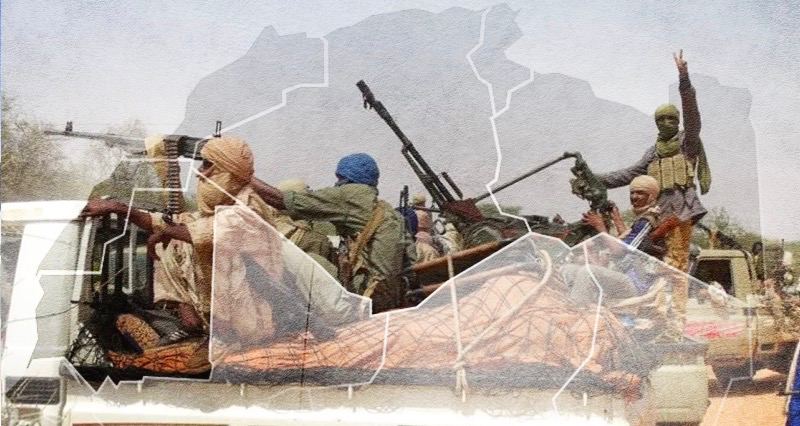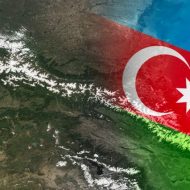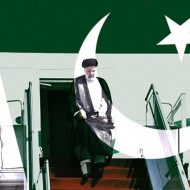As stated in previous materials, the Tuareg historically live in the territory of Mali, Niger, Libya, Algeria, some of them live in the north of Burkina Faso. But the Tuaregs are part of the large Berber people, which represents an ancient cultural space that unites vast territories in North Africa, the Sahara and certain areas of the Sahel. Tribes that have survived from the ancient Berber-Libyan civilization inhabit different zones of Africa: these are the Kabyles, Shauyas, Shillou, Tuaregs and others.
Anthropologically and linguistically, the Berbers differ from the Egyptians, Arabs and black people of the rest of Africa, they have pronounced Caucasian features and light skin color, and in addition, a pronounced matriarchal structure of society. Having undergone Arabization and Islamization, the Berbers, unlike the Egyptians, did not lose their identity, partly retreating to the rugged regions of the Sahara and the extreme west of North Africa, and partly by entering into treaty relations with the Arabs, which allowed them to preserve certain aspects of their identity and relative tribal sovereignty.
The Tuaregs are ones of those who least assimilated into the Arab environment, retaining their identity, their language (Tamashek), and even with Islamization, they retained a matriarchal system, as well as a nomadic way of life, which did not allow them to form their own statehood. This led to many conflicts between the Tuaregs and the local authorities of the Sahel countries in the 20th and 21st centuries; now French and American neo-colonialists are taking advantage of their peripheral position in order to shake up the situation in Africa.
Now Tuareg separatist sentiments are strongest in Mali, where they advocate liberating the territory of Azawad and establishing their control there. In Libya, the Tuaregs control oil and gas production and supply routes in the historical Fezzan region. In general, the Tuaregs try to increase their influence in the Sahel, but some of them live in Northwest Africa. Is it possible that their presence there could affect the destabilization of the situation throughout the North, in the Sahel and Maghreb regions?
Tuaregs in Mauritania
In total, the Tuaregs number 4 million people, most of them living in Mali, Niger and Libya. In Mauritania their number reaches 140 thousand people. However, the Tuaregs came to Mauritania later than to the Sahel regions, brought there by trade, so in this country their influence on other ethnic groups has never been strong.
A separatist group consisting of Islamists, Al-Qaeda in the Islamic Maghreb (AQIM), was active in Mauritania. In addition to the Mauritanians, the organization included Algerians, Moroccans, as well as local Saharawi communities, including Tuaregs. Their members also intermarried with the local community. This group has been present in Mali since 2003. Since 2017, the Sahrawi branch of AQIM has merged with the Macina Liberation Front, Ansar Dine and Al-Murabitoun factions into Jama’a Nusrat ul-Islam wa al-Muslimin (JNIM). The leader of JNIM is the Tuareg Iyad Ag Ghali.
In 2012, during the Tuareg uprising in Mali, the Mbera refugee camp in Mauritania hosted 100,000 refugees, mostly of Tuareg origin. This camp was founded during the previous Tuareg separatist uprising in the early 1990s. During the 2012 uprising, Mauritania helped Mali suppress separatist activities. President Mohamed Ould Abdel Aziz, along with Malian officials, said that the National Movement for the Liberation of Azawad MNLA had collaborated with AQIM.
Following the 2020 coup in Mali, the Mauritanian Foreign Minister met with the new Malian authorities. The countries cooperate in the fight against terrorism and groups such as AQIM and JNIM. Mauritania and Mali are separated by a 2,237 km border, and extremist organizations operate along the two countries’ shared border. As of 2019, there were 56,591 refugees from Mali living in Mauritania, some of whom were Tuaregs.
In 2023, following renewed Tuareg clashes with the new government in Bamako, Nouakchott refused to accept wounded rebels from fighting with the Malian army. The historic city of Timbuktu in northern Mali, near the border with Mauritania, has been the center of fighting between the military and a rebel group called the Coordination of Azawad Movements (CMA). The Malian army launched an offensive in August 2023 to dislodge rebels who control the region around the city.
Morocco and Western Sahara
The Tuareg factor in Morocco and Western Sahara is practically not traced. Saharan nomads, the Tuaregs and other Berbers, once controlled the caravan trade between Morocco and Niger. In recent decades, more and more of them have settled in oases, where they engage in agricultural work. These nomads live on the edge of the desert (for example, in the village of M’Hamid El Ghizlane).
Some Saharan tribes are involved in the political life of Morocco, for example, many of them participate in Morocco’s war against the SADR in Western Sahara. Morocco lays claim to the lands of Western Sahara, in which the self-proclaimed state of the Sahrawi Arab Democratic Republic was formed. From the UN’s perspective, the status of this territory is a matter of debate: some countries recognize the SADR, others believe that Western Sahara is part of Morocco. Some countries, including Türkiye, support the plan to create Autonomy of Western Sahara within Morocco.
The borders of Western Sahara, as well as the borders of other African countries, were delineated arbitrarily – in 1884 these lands were a colony of Spain. Less than a century later, in 1975, Spain transferred administrative control of the territory to Morocco and Mauritania following the signing of the Madrid Agreements. Moroccan troops entered the territory from the northeast and clashed with the Popular Front for the Liberation of Saguia el-Hamra and Río de Oro (Polisario).
Most of the region is today controlled by Morocco and only a quarter is controlled by the SADR. In 2020, new armed clashes began, which are still breaking out, despite the ceasefire. The conflict has led to many Western Saharan tribes having to migrate to refugee camps located mainly in Algeria. Despite the migration of more than 170 thousand people in the region, the Polisario managed to resist the Moroccan army. The Moroccans’ failures also often contributed to the ineffectiveness of their army – forcibly conscripted black Africans from the south of the country resisted mobilization because they saw it as an intra-Arab conflict in the north.
The tribes of northern Mauritania often sympathized with the Polisario, fearing Morocco’s possible regional ambitions. The country is considered a friend of France and a vehicle for Paris’ ambitions in northern Africa. Accordingly, many tribes fighting for independence and resisting colonialism oppose any military action by Morocco.
At the present stage, the Tuareg factor does not appear in this region. Morocco and Western Sahara are inhabited by Arab and Berber tribes such as the Sahrawis, Libyans, and Mauritians. Some Berber tribes of the northwestern Sahara lead a nomadic lifestyle and do not influence the political environment. The main passionate segment of the Tuaregs is most clearly expressed in Mali, Niger and Libya.
Although some researchers believe that it was the unrest in Western Sahara against Moroccan policies in 2010-2011 that led to uprisings and civil wars throughout the Arab world in those years, including the war in Libya and the Tuareg uprising in Mali. But the Tuareg problem itself resulted in other factors: the genocide of nomadic tribes by the French in 1912-1915, gaining small independence in the 1960s, drought and crop failure of the 1970-1980s, which forced Tuaregs to actively engage in the political life of Mali and Niger.









Leave a Reply